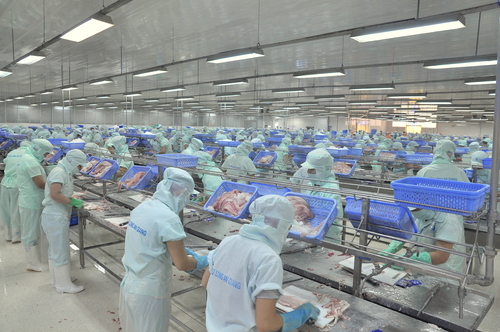Serving Prepared Foods Safely
Because prepared foods are fresh and unadulterated, bacteria can grow if they are not handled properly.
 Bringing Home Prepared Foods
Bringing Home Prepared Foods
Bringing home fresh and delicious prepared foods is a good alternative to cooking, however, there are some guidelines to follow:
Buying it Hot
If you will be dining within two hour, pick up your food hot and keep it hot. Make sure to travel home, serve and eat your food within 2 hours from the time you pick it up.
If not eating immediately, keep your food hot, not warm. Set the oven temperature high enough to keep the food between 140 ° F and 165 ° F (use a meat thermometer to check). Make sure all of the food stays hot, including side dishes. Cover with foil to keep foods from drying out. To keep your food tasting good, don’t hold hot foods for longer than two hours before serving.
To serve hot foods later; divide into small portions, place in shallow containers, and refrigerate or freeze. Remove stuffing from whole cooked poultry and refrigerate separately.
Buying it Cold
Buy cold prepared foods at the end of your shopping trip so they do not warm up in your car. Take them directly home and refrigerate or freeze immediately. If your trip home is longer than 30 minutes, place your cold prepared foods in a cooler with ice.
Deli meats, also known as “cold cuts” need to remain cold as well. Most refrigerated deli meats are safe to eat for 3 to 5 days; more sensitive cuts like turkey, chicken breast, and rare roast beef may be good for only 2 to 4 days. Buy an appropriate amount to be consumed within these time frames or freeze the extras. If left out of refrigeration for more than two hours, deli meats should be discarded.
Heating it Up
Whether you purchased your prepared foods hot or cold, you need to take care in heating up your meal. Using an oven, microwave, or stovetop, heat foods thoroughly to 165º F — until hot and steaming. Bring gravy to a rolling boil. If heating in a microwave oven, cover food and rotate the dish so it heats evenly. Inadequate heating in a microwave can contribute to illnesses. Consult your microwave owner’s manual for complete instructions
Entertaining Safely
Dishing it Out
Serving foods buffet-style can help make entertaining a number of guests more enjoyable for the host. Just make sure to keep hot foods hot and cold foods cold.
- Keep hot foods at 140º F or warmer by using chaffing dishes, slow cookers and warming trays.
- Keep cold foods at 40º F or cooler by nesting dishes in bowls of ice. You may also use small serving trays and replace them often.
- Make sure there are plenty of serving utensils to help your guests serve themselves without mixing foods from different dishes.
- Be sure to provide a serving spoon and plates for dips and salsas. Placing chips and dips at opposite ends of the buffet table may also help discourage “double-dipping.”
Outdoor Parties.
Picnics and tailgate parties can be lots of fun as long as you plan for the situation.
- A well-insulated cooler packed with ice or reusable cold packs is a fine alternative to a refrigerator.
- Make sure the foods you pack in the cooler, whether purchased or made at home, have been kept below 40º F.
- Open the cooler as infrequently as possible to retain cold air.
- Although it may look nice to set all of the food out on picnic table, it is safer to leave cold foods in the cooler until right before eating.
- Remember the 2-hour rule when food is removed from the cooler. If the outside temperature is over 90º F, the 2-hour rule drops to only 1 hour – so plan accordingly.
Keeping it Fresh
While it is admirable to not waste good food, be careful to avoid food-borne illness in the process. When in doubt, throw it out.
Leftovers
- Any food that has been left on a buffet table or in a cooler with melting ice for more than 2 hours must be discarded.
- Other leftovers can be divided into smaller portions, placed in shallow containers, and refrigerated or frozen.
- In general, refrigerated leftovers should be used within 4 days. Frozen leftovers will have the best quality if used within 2 to 4 months.
Storage Chart for Leftovers
Prepared Food Item Refrigerated Frozen
Cooked meat or poultry 3 to 4 days 3 to 6 months
Fried Chicken 3 to 4 days 4 months
Pizza 3 to 4 days 1 to 3 months
Egg or tuna salad 3 to 5 days does not freeze well
Pasta salad 3 to 5 days does not freeze well
Potato salad 3 to 5 days does not freeze well
Bean salad 3 to 5 days does not freeze well
Green salad 1 to 2 days does not freeze well
Deli meats 3 to 5 days 1 to 2 months
Gravy 1 to 2 days 2 to 3 months
Casseroles 3 to 4 days 2 to 3 months
Sources:
Partnership for Food Safety Education, Food Marketing Institute, Food and Drug Administration (FDA), US Department of Agriculture (USDA),
Wittenberg, Margaret Good Food-The Complete Guide to Eating Well. Freedom, CA: The Crossing Press, 1995
For a good source of Whole Food Supplements
For information on health problems and what can be done, see the MCVitamins.com Index. You can also email us and get help.
Sign up to receive the MCVitamins Newsletter!
Up-to-date info on the latest health-related news happening in the world
(available in English only)

